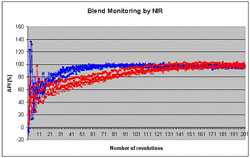Bin Blending
The blending of pharmaceutical ingredients is one of the critical processes during the production of pharmaceuticals. Product homogeneity and further processing is dependant on the characteristics of the incoming material and process conditions. Sample taking and analysis at the end of the process is most commonly used for quality control, however this does not provide any information to enable optimisation of the process and doesn't provide any process information.
Applying online NIR to this process allows the determination of the blending end point by statistical methods. Beside this option the quantitative analysis of API or functional ingredients by applying a chemometric calibration is possible too. Based on the gained process data it is possible to optimize blending time, avoid faulty batches and prevent blend from being separated due to over-blending.

There is no longer need for conventional thief sampling and laboratory analysis which retard manufacturing processes and therewith raise production costs. This makes a PAT solution to a very valueable tool in process and formulation development, up-scaling, and routine use. Fully implemented and applied the online monitoring of blend uniformity is a key element for real-time release.

Many different approaches to monitor this unit operation and to detect the end point of the mixing process are realized. The selection of the best suited one is very strong depending on the product or range of products the NIR is applied to. The most commonly used methods are:
- Simple spectral statistics such as Standard Deviation in a certain wavelength range or even small absorbance range
- Advanced statistical calculation using Moving Block Standard Deviation and Moving Block FTest both in combination with mathematical pretreatments
- Calculation and monitoring of area values for absorbance bands of actives
- Qualitative analysis based on Principal Component Analysis (PCA)
- Quantitative monitoring of API or functional ingredients based on chemometric models, e.g. PLS
- Combination of different approaches listed above, e.g. statistics such as RSD applied to quantitative values